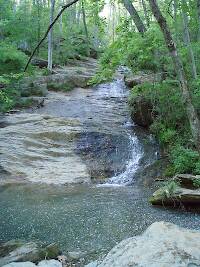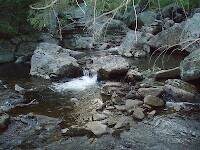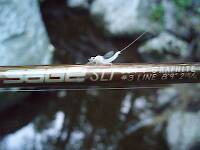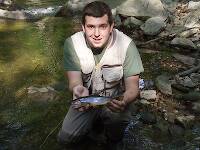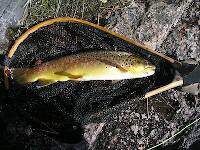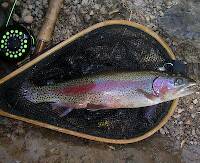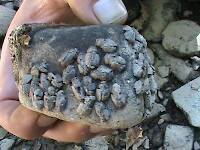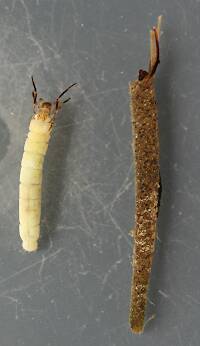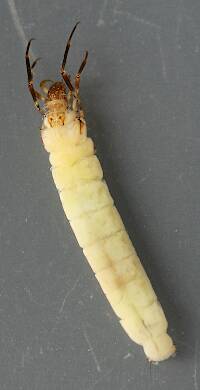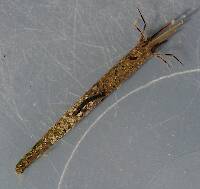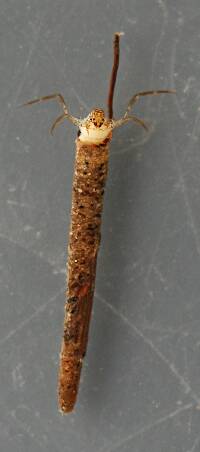
Blue-winged Olives
Baetis
Tiny Baetis mayflies are perhaps the most commonly encountered and imitated by anglers on all American trout streams due to their great abundance, widespread distribution, and trout-friendly emergence habits.
Featured on the forum

With a bit of help from the microscope, this specimen keys clearly and unsurprisingly to Hydropsyche.

Troutnut is a project started in 2003 by salmonid ecologist Jason "Troutnut" Neuswanger to help anglers and
fly tyers unabashedly embrace the entomological side of the sport. Learn more about Troutnut or
support the project for an enhanced experience here.
PaulRoberts on Aug 15, 2012August 15th, 2012, 9:14 am EDT
I found many of these cases in early August under rocks along the shorelines of a high gradient canyon stream in Colorado. All were empty, having emerged already.
I’m guessing they are Lepidostoma. They were quite small (5 or 6mm). One notable behavior was that, for pupation, they had attached their cases to the rocks by the tail end of the tapered case, and were often clumped (3 to 8 or so) all attached to the same specific spot on their given rock.


Has anyone fished this emergence?
I’m guessing they are Lepidostoma. They were quite small (5 or 6mm). One notable behavior was that, for pupation, they had attached their cases to the rocks by the tail end of the tapered case, and were often clumped (3 to 8 or so) all attached to the same specific spot on their given rock.


Has anyone fished this emergence?
Entoman on Aug 15, 2012August 15th, 2012, 1:42 pm EDT
Hi Paul,
I have quite a bit of angling experience with this genus. The species Lepidostoma podagrum is an important species on one of my home rivers and has been a frequent cause of selective activity on late Summer and early Fall evenings. The last few years, their populations seem to be on the upswing. For some reason, a series of larval and adult photos (both sexes) I entered on its Species Hatch Page last year are not showing up. The same photos along with detailed analysis (including a very interesting but off- topic detour through insect wings and baetis behavior before it gets back on track) are available on Taxon's website:
http://flyfishingentomology.com/forum/Replies_Display.php?t=0120 The photos are spread over several other topics listed by species name so check them out as well.
The cases of this genus are quite variable. The habitats I find podagrum in are sandy areas and/or weedy spots near springs. Do you think the colonies you are finding are near springs? The freestone cobble of a high gradient stream causes me pause as there are others that can have similar looking cases (Apatania for example). Did you see any brown caddis about with hairy scapes and unusual palps?
I have quite a bit of angling experience with this genus. The species Lepidostoma podagrum is an important species on one of my home rivers and has been a frequent cause of selective activity on late Summer and early Fall evenings. The last few years, their populations seem to be on the upswing. For some reason, a series of larval and adult photos (both sexes) I entered on its Species Hatch Page last year are not showing up. The same photos along with detailed analysis (including a very interesting but off- topic detour through insect wings and baetis behavior before it gets back on track) are available on Taxon's website:
http://flyfishingentomology.com/forum/Replies_Display.php?t=0120 The photos are spread over several other topics listed by species name so check them out as well.
The cases of this genus are quite variable. The habitats I find podagrum in are sandy areas and/or weedy spots near springs. Do you think the colonies you are finding are near springs? The freestone cobble of a high gradient stream causes me pause as there are others that can have similar looking cases (Apatania for example). Did you see any brown caddis about with hairy scapes and unusual palps?
"It's not that I find fishing so important, it's just that I find all other endeavors of Man equally unimportant... And not nearly as much fun!" Robert Traver, Anatomy of a Fisherman
Creno on Aug 15, 2012August 15th, 2012, 8:13 pm EDT
These cases are probably Lepidostoma. But I doubt L. podagrum. As far as I know the L. podagrum group has vegetation panel cases. In most caddis (limnephilds being the primary NA exception) pupal cases are not variable within a species. If the pupal case of two caddis specimens collected next to each other is different they are probably different species. They don't really vary by habitat, especially in trout streams. I looked at the discussion on Taxon's site and the pub you should look at for Lepidostoma is Weaver 1988. Lots of great info there. But it won't help you with taxa described after that. stuff happens....... A problem for all the
These are not Apatania cases - Apatania cases, and others, are wider at the head end. The taper is shorter with the head end usually near 2 times, or more, teh width of the the rear end.
These are not Apatania cases - Apatania cases, and others, are wider at the head end. The taper is shorter with the head end usually near 2 times, or more, teh width of the the rear end.
PaulRoberts on Aug 16, 2012August 16th, 2012, 7:39 am EDT
Thanks, guys.
From images I've seen they do look less like Apatania, for reasons Creno states. And a lot more like the sand-cased Lepidostoma.
I have Ward and Kondratieff (1992) Mountain Stream Insects of Colorado and they state that then-available larval keys are not sufficient to the species level. That may have changed. Lafontaine has a nice write up on the genus and lists several species that occupy mountain streams, as well as those that live in spring seeps, river backwaters, even stillwater edges.
Looks like I likely missed this emergence this year, but next year I have another "in" to take advantage of. I read in a couple sources that larvae become active just prior to pupation and many spill into the drift. I've done well with Brachycentrus larval case ties in this stream in spring and will likely add a Lepidostoma cased pattern for summer.
From images I've seen they do look less like Apatania, for reasons Creno states. And a lot more like the sand-cased Lepidostoma.
I have Ward and Kondratieff (1992) Mountain Stream Insects of Colorado and they state that then-available larval keys are not sufficient to the species level. That may have changed. Lafontaine has a nice write up on the genus and lists several species that occupy mountain streams, as well as those that live in spring seeps, river backwaters, even stillwater edges.
Looks like I likely missed this emergence this year, but next year I have another "in" to take advantage of. I read in a couple sources that larvae become active just prior to pupation and many spill into the drift. I've done well with Brachycentrus larval case ties in this stream in spring and will likely add a Lepidostoma cased pattern for summer.
Entoman on Aug 16, 2012August 16th, 2012, 9:55 am EDT
My pleasure, Paul. I really enjoy this stuff. Just to clarify from Dave's helpful comments, I hope I didn't lead you to believe I think your photos are of either another family or paradoxically the species I referred to. I should have been more clear that I agreed with your assessment they probably represent the genus Lepidostoma. I mentioned the species only because you asked about experiences with the genus, so I thought I'd share one of mine. As for the cases, I have seen photos in the record that blur the lines enough for my limited abilities (specifically Merritt IV among others) that without a look at the larvae, I felt the need to qualify my opinion. If an expert like Dave is confident that they aren't the optional possibility I gave, that's certainly good enough for me.
I should have also added that as a genus they are widely distributed and are in my opinion probably the best "dry fly" caddis I've fished over. They are certainly the most "mayfly like" in my experience, spending a fair amount of time on the surface both emerging and egg-laying, and they do so fairly sedately (for a caddis:)). However, I don't recall seeing them in the numbers on freestone streams that rival what I've seen on Spring Creeks, particularly the example I gave.
Hopefully Dave has more to share on this, but that's largely my understanding as well. Though there are a few species that can be identified by unique larval characters, most are placed in groups based on case design as follows:
1. Panel case (often four sided like Brachycentrus but with panels looking a little like small Phryganea)
2. Turret case ( stuff sticking out all over. ex. podagrum, see photos)
3. Sand case (your specimens probably belong to this group)
4. Pluviale (similar to the sand case, but more tapered and more curved)
5. Tube (similar to the sand case, but without curve)
For case examples that blur the lines in the last three groups, head capsule characters and presence or lack of gills are further aids in differentiating them.
I should have also added that as a genus they are widely distributed and are in my opinion probably the best "dry fly" caddis I've fished over. They are certainly the most "mayfly like" in my experience, spending a fair amount of time on the surface both emerging and egg-laying, and they do so fairly sedately (for a caddis:)). However, I don't recall seeing them in the numbers on freestone streams that rival what I've seen on Spring Creeks, particularly the example I gave.
I have Ward and Kondratieff (1992) Mountain Stream Insects of Colorado and they state that then-available larval keys are not sufficient to the species level.
Hopefully Dave has more to share on this, but that's largely my understanding as well. Though there are a few species that can be identified by unique larval characters, most are placed in groups based on case design as follows:
1. Panel case (often four sided like Brachycentrus but with panels looking a little like small Phryganea)
2. Turret case ( stuff sticking out all over. ex. podagrum, see photos)
3. Sand case (your specimens probably belong to this group)
4. Pluviale (similar to the sand case, but more tapered and more curved)
5. Tube (similar to the sand case, but without curve)
For case examples that blur the lines in the last three groups, head capsule characters and presence or lack of gills are further aids in differentiating them.
"It's not that I find fishing so important, it's just that I find all other endeavors of Man equally unimportant... And not nearly as much fun!" Robert Traver, Anatomy of a Fisherman
PaulRoberts on Aug 16, 2012August 16th, 2012, 1:59 pm EDT
Thanks Kurt. I know you enjoy discussing the entomological possibilities in fishing. You sure help make this site worth spending precious time at.
I'll likely add small dry and pupal versions as well esp if these critters exist further down the watershed where the gradient smooths out some. I plan to be there tomorrow so I'll check it out.
I'll likely add small dry and pupal versions as well esp if these critters exist further down the watershed where the gradient smooths out some. I plan to be there tomorrow so I'll check it out.
Entoman on Aug 16, 2012August 16th, 2012, 2:47 pm EDT
Thanks Paul. Let me know what you find out/come up with. I've had good luck with a modified E/C Caddis during emergence, and one of several flush floating down wing dry flies effective for the egg layers. One of the things I really like about this caddis is that the dries out-fish the wets and they like them dead drift.
"It's not that I find fishing so important, it's just that I find all other endeavors of Man equally unimportant... And not nearly as much fun!" Robert Traver, Anatomy of a Fisherman
Sayfu
Posts: 560
Posts: 560
Sayfu on Aug 19, 2012August 19th, 2012, 8:58 am EDT
I like Lawson's notion of representing the egg layers that can dive, and the emerging caddis. He wraps with that "antron" yarn I mentioned, and then takes the remainder of the strand, and combs it out, and it lays back as an underwing, under his partridge pinched down hackle, and the underwing joins in profile the short piece of the same yarn used as a tail shuck. He feels this works just as well as LaFontaine's encased antron. Sure does make it easy.
Entoman on Aug 19, 2012August 19th, 2012, 10:39 am EDT
Jere -
Yes, I agree.
Yes, I agree.
"It's not that I find fishing so important, it's just that I find all other endeavors of Man equally unimportant... And not nearly as much fun!" Robert Traver, Anatomy of a Fisherman
Quick Reply
Related Discussions
Topic
Replies
Last Reply
2
Feb 15, 2013
by Troutnut
by Troutnut
1
Aug 6, 2019
by Troutnut
by Troutnut
Re: Help obtaining photos of larval insects for a City of Denton, TX photographic key to ID'ing.
In the Identify This! Board by Rdjudy
In the Identify This! Board by Rdjudy
1
Jul 28, 2008
by Taxon
by Taxon





